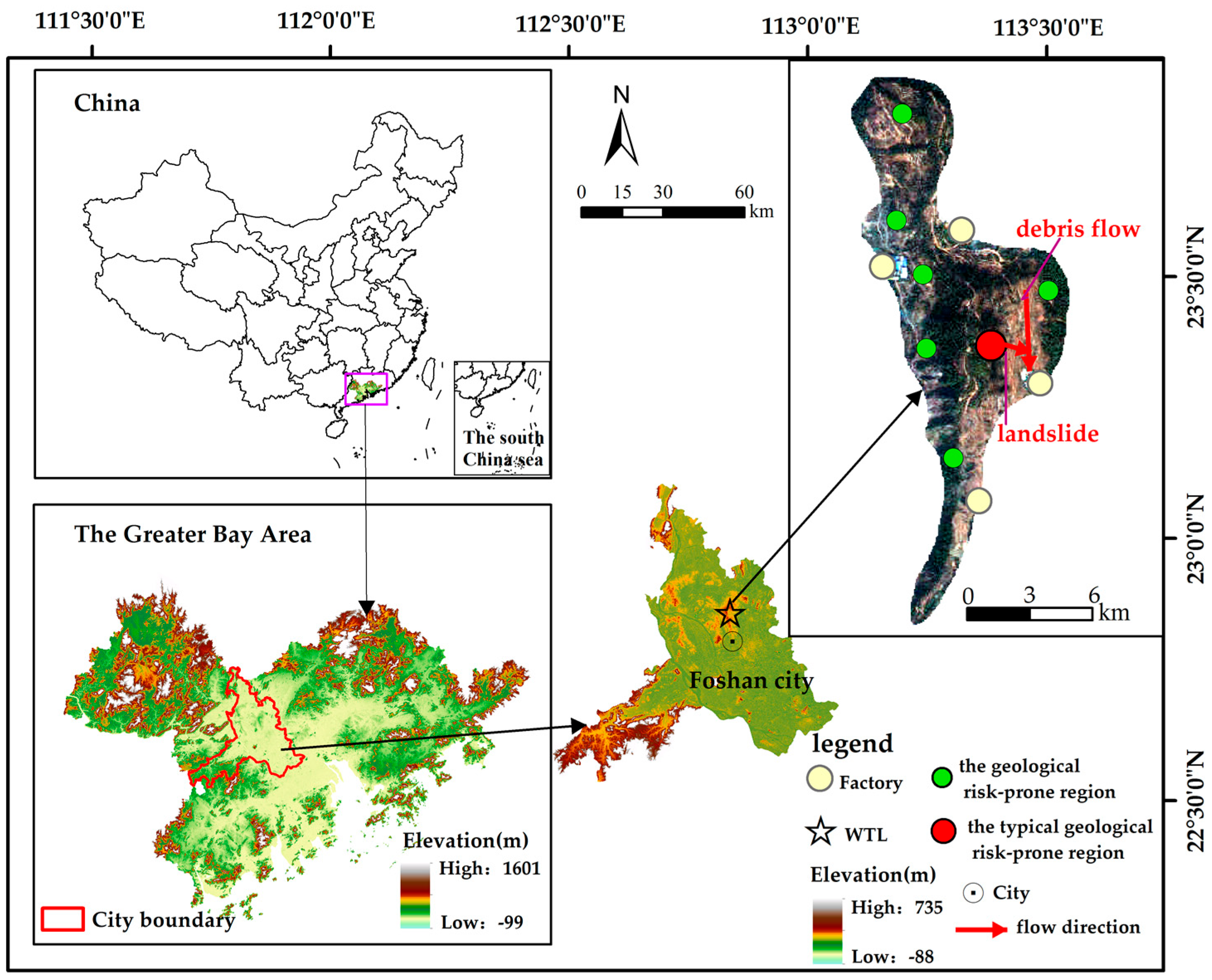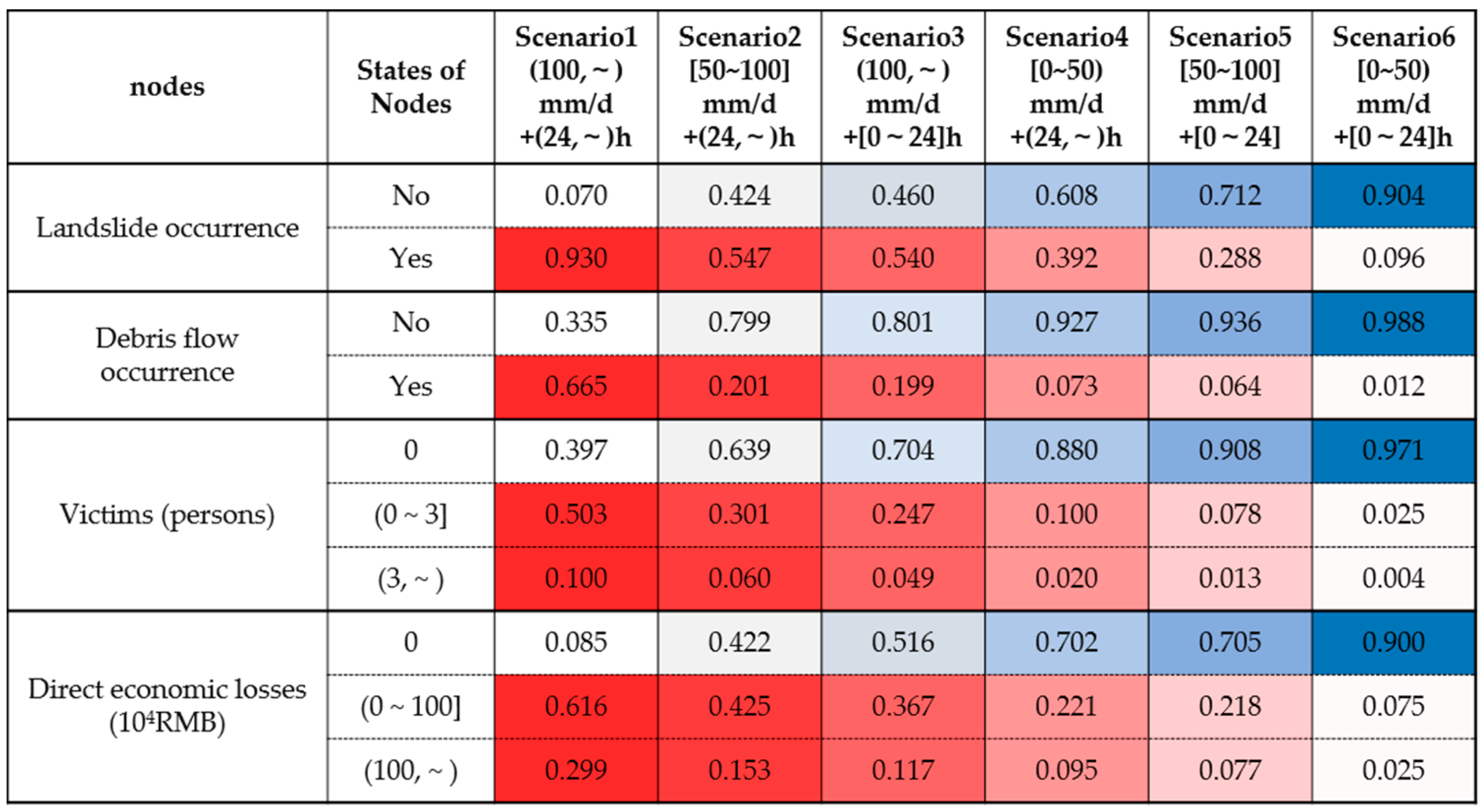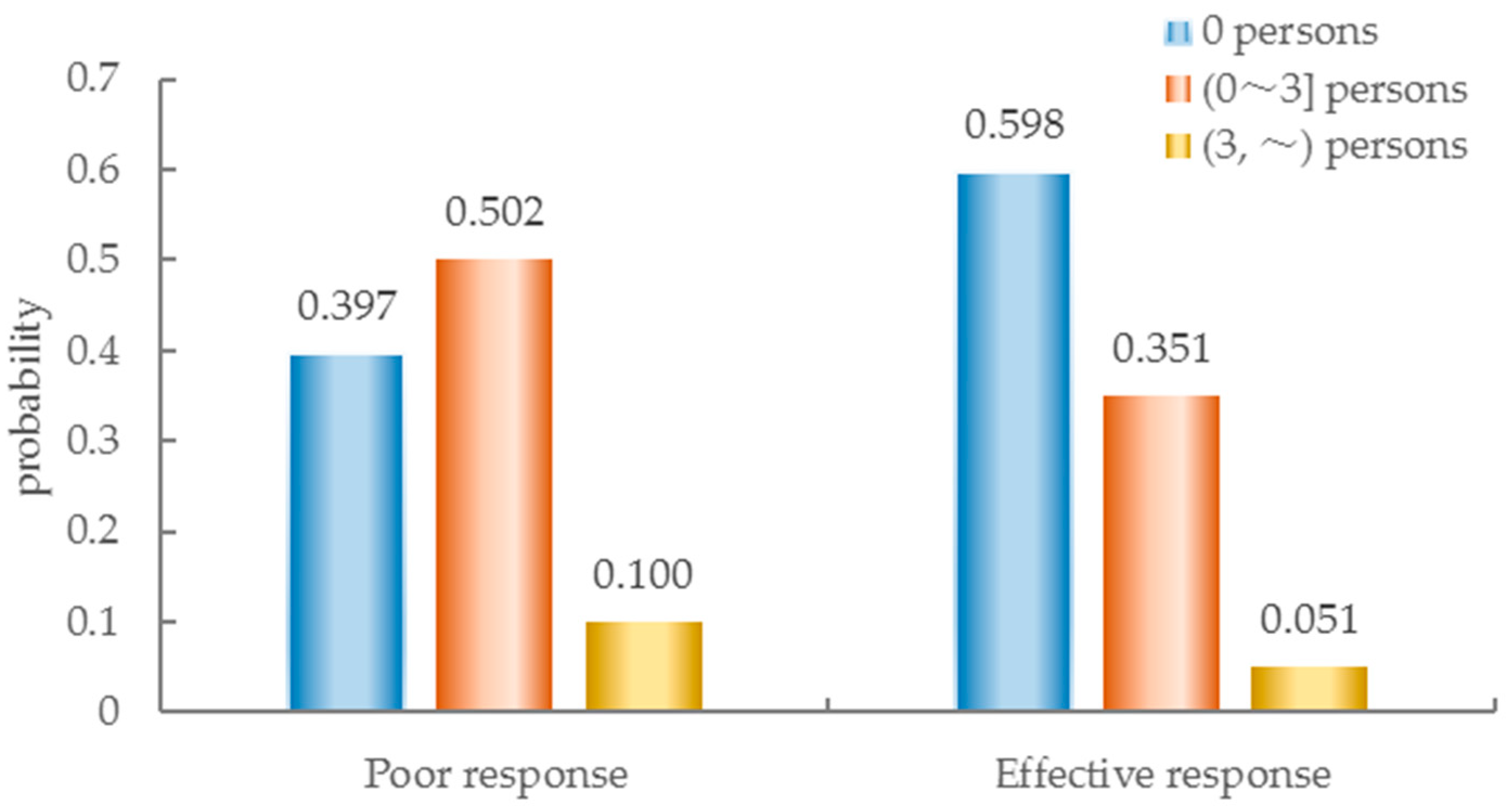A Bayesian Network-Based Inhibition Model of the Rainstorm–Landslide–Debris Flow Disaster Chain in Mountainous Areas: The Case of the Greater Bay Area, China
Abstract
:1. Introduction
2. Materials and Methods
2.1. Description of the Study Area
2.2. Data Source
2.3. Methods
2.3.1. Steps for Developing the Inhibition Model of the R-L-D Disaster Chain
2.3.2. Determining BN Nodes
- (a)
- Rainfall intensity (mm·d−1). Rainfall intensity is an important parameter describing the rainstorm. In this study, rainfall intensity is divided into three states, ([0~50), [50~100], and (100,~)) mm·d−1, each having different consequences.
- (b)
- Rainfall duration (h). Rainfall duration refers to any continuous period of rainfall. The longer the rainfall duration is, the more the moisture accumulates in the soil, and, consequently, the higher the probability of disaster will be. In this study, rainfall duration is divided into two states ([0~24] and (24,~)) h.
- (c)
- Lithology weakness. According to the detailed survey report of the WTL regional geological disaster, we can classify rocks as strongly weathered rocks and weakly weathered rocks based on their composition, so “Lithology weakness” is divided into two states (No and Yes).
- (d)
- Geological structure. Geological structure describes the deformation and fracture development of rocks; if there are obvious deformations and fracture developments in rocks in the mountain, the Geological structural node state is Instability, otherwise, it is Stability.
- (e)
- Slope (°). Slope is the ratio of the vertical height to the horizontal width of the slope. In this study, slope is divided into two states ([0~30] and (30,~))°.
- (f)
- Emergency rescue. Emergency rescue is divided into two states (Effective Response, characterized by a timely arrival at the disaster site and effective rescue, and Poor Response, characterized by a failure to implement a successful rescue at the earliest possible time).
- (g)
- Landslide occurrence. It is divided into two states (No and Yes).
- (h)
- Landslide volume (104 m3). Landslide volume is divided into three states (0, (0~10], and (10,~))104 m3 according to the historical disaster data of the GBA and the classification standard of landslides proposed by the China Geological Survey.
- (i)
- Debris flow occurrence. It is divided into two states (No and Yes).
- (j)
- Debris flow volume (104 m3). It is divided into three states (0, (0~2] and (2,~)) 104 m3 according to the historical disaster data of the GBA and the classification standard of debris flow proposed by the China Geological Survey.
- (k)
- Death (persons). Death is the most important factor for evaluating Disaster Result. It is divided into three states (0, (0~3], and (3,~)) persons according to the historical disaster data of the GBA and the governmental classification standard of disaster proposed by the China Geological Survey.
- (l)
- Direct economic loss (104 RMB). Direct economic loss is a quantitative measure of the consequence of a disaster, and it is divided into three states (0, (0~100) and (100,~)) 104 RMB.
2.3.3. Determining BN Structure
2.3.4. Determining the Conditional Probability Table of BN Nodes
2.3.5. Validating BN Model
- (1)
- The typical R-L-D disaster chain event. On 7 May 2017, a rainstorm occurred in the geological risk-prone regions of WTL and triggered landslides and debris flow, causing 2 deaths, the collapse of more than 50 houses, damage to numerous public facilities such as roads and electricity infrastructures, and a direct economic loss of approximately RMB 883,000.
- (2)
- Inference and validation. According to the environmental geological data and the disaster data in this event, the nodes of Hazardous Factor and Response Operation are set as follows: (a) rainfall intensity is set at (100,~) mm.d−1; (b) rainfall duration is set at (24,~) h; (c) Lithology weakness is set at Yes; (d) Geological structure is set at Instability; (e) Slope is set at (30,~)°; and (f) Emergency rescue is set at Poor response. The BN model is used to infer the posterior probability of other nodes (Table 4). The maximum posterior probabilities in Table 4 are taken as the predicted values, which are then compared with the measured values (Table 5). It is seen from Table 4 that there is a good agreement between the predicted and measured values, and the B value (0.207) calculated using the Brier score is lower than 0.6, which indicates that the proposed inhibition model is reliable and therefore it can be used for subsequent scenario analysis.
3. Results and Discussion
3.1. Impact of Rainfall Scenario on the R-L-D Disaster Chain
3.2. The Inhibitory Effects of Environmental Geological Conditions on the R-L-D Disaster Chain
3.3. The Inhibitory Effect of Rescue Speed on the R-L-D Disaster Chain
3.4. Inhibition Framework for the R-L-D Disaster Chain
4. Conclusions
- (1)
- On the basis of the B value (0.207 < 0.6) calculated using the Brier score method, the feasibility of the inhibition model is verified.
- (2)
- Different rainfall scenarios are set by combining the types of Hazardous Factor and Response Operation nodes in a typical geological risk-prone region of WTL, and the probabilities of BN nodes under different rainfall scenarios are analyzed. Under the most unfavorable rainfall scenario ((100,~) mm/d + (24,~) h), the probability of landslides and debris flow is 0.930 and 0.665, respectively. Improving environmental geological conditions such as slope, lithology, and geological structure can greatly inhibit the occurrence of the R-L-D disaster chain. Moreover, the improvement of the geological structure condition is the most significant, and reduces the probability of landslides and debris flow by 0.684 and 0.430, respectively, as well as reducing the probability of death and direct economic loss by 0.411 and 0.619, respectively. The inhibitory effect follows the order of geological structure > slope > lithology. Increasing the rescue speed reduces the probability of death and direct economic loss from 0.603 and 0.915 to 0.402 and 0.560, respectively.
Supplementary Materials
Author Contributions
Funding
Data Availability Statement
Acknowledgments
Conflicts of Interest
References
- Peng, J.B.; Fan, Z.J.; Wu, D.; Zhuang, J.Q.; Dai, F.C.; Chen, W.W.; Zhao, C. Heavy rainfall triggered loess–mudstone landslide and subsequent debris flow in Tianshui, China. Eng. Geol. 2015, 186, 79–90. [Google Scholar] [CrossRef]
- Mori, S.; Ono, K. Landslide disasters in Ehime Prefecture resulting from the July 2018 heavy rain event in Japan—ScienceDirect. Soils Found. 2019, 59, 2396–2409. [Google Scholar] [CrossRef]
- Shi, P.J. Theory and practice of disaster study. J. Nat. Disasters 1996, 5, 8–19. [Google Scholar]
- Zhang, T.T.; Yin, Y.P.; Li, B.; Liu, X.J.; Wang, M.; Gao, Y.; Wan, J.W.; Gnyawali, K.R. Characteristics and dynamic analysis of the February 2021 long-runout disaster chain triggered by massive rock and ice avalanche at Chamoli, Indian Himalaya. J. Rock Mech. Geotech. Eng. 2023, 15, 296–308. [Google Scholar] [CrossRef]
- Selva, J. Long-term multi-risk assessment: Statistical treatment of interaction among risks. Nat. Hazards 2013, 67, 701–722. [Google Scholar] [CrossRef]
- Kappes, M.S.; Keiler, M.; Elverfeldt, K.V.; Glade, T. Challenges of dealing with multi-hazard risk: A review. Nat. Hazards 2012, 64, 1925–1958. [Google Scholar] [CrossRef]
- Xu, L.F.; Meng, X.W.; Xu, X.G. Natural hazard chain research in China: A review. Nat. Hazards 2014, 70, 1631–1659. [Google Scholar] [CrossRef]
- Niu, X.D.; Hou, K.P.; Sun, H.F. Study on the Prevention and Control of Downhole Debris Flows Based on Disaster Chain Theory. Water 2023, 15, 2367. [Google Scholar] [CrossRef]
- Chen, H.; Dadson, S.; Chi, Y.G.C. Recent rainfall-induced landslides and debris flow in northern Taiwan. Geomorphology 2006, 77, 112–125. [Google Scholar] [CrossRef]
- Kim, S.-W.; Chun, K.-W.; Otsuki, K.; Shinohara, Y.; Kim, M.; Kim, M.; Lee, D.; Seo, J.; Choi, B. Heavy rain types for triggering shallow landslides in South Korea. J. Fac. Agric. Kyushu Univ. 2015, 60, 243–249. [Google Scholar] [CrossRef]
- Du, W.J.; Sheng, Q.; Fu, X.D.; Chen, J.; Wei, P.F.; Zhou, Y.Q. Post-failure analysis of landslide blocking river using the two-phase double-point material point method: A case of western Hubei. China. Bull. Eng. Geol. Environ. 2023, 82, 98. [Google Scholar] [CrossRef]
- Cui, Y.; Kong, J.M.; Tian, S.J.; A, F.Y. The Critical Role for Heavy Rainfall in the Evolution of the Mountain Hazards Chains. J. Mt. Sci. 2011, 29, 87–94. [Google Scholar]
- Iida, T. A stochastic hydro-geomorphological model for shallow landsliding due to rainstorm. Catena 1999, 34, 293–313. [Google Scholar] [CrossRef]
- Li, C.R.; Wang, M.; Chen, F.; Coulthard, T.J.; Wang, L. Integrating the SLIDE model within CAESAR-Lisflood: Modeling the ? rainfall-landslide-flash flood? disaster chain mechanism under landscape evolution in a mountainous area. Catena 2023, 227, 107124. [Google Scholar] [CrossRef]
- Miura, T.; Nagai, S. Landslide Detection with Himawari-8 Geostationary Satellite Data: A Case Study of a Torrential Rain Event in Kyushu, Japan. Remote Sens. 2020, 12, 1734. [Google Scholar] [CrossRef]
- Iuliis, M.D.; Kammouh, O.; Cimellaro, P.; Tesfamariam, S. Quantifying restoration time of pipelines after earthquakes: Comparison of Bayesian belief networks and fuzzy models. Int. J. Disaster Risk Reduct. 2021, 64, 102491. [Google Scholar] [CrossRef]
- Chen, Z.G.; Song, J.; Yang, Y.P. Similarity Measurement of Metadata of Geospatial Data: An Artificial Neural Network Approach. ISPRS Int. J. Geo-Inf. 2018, 7, 90. [Google Scholar] [CrossRef]
- Buendia-Buendia, F.S.; Buendia, G.; Andina, D. Determining geostrophic wind direction in a rainfall forecast expert system. Integr. Comput. Aided Eng. 2019, 26, 111–121. [Google Scholar] [CrossRef]
- Qiu, J.G.; Wang, Z.Q.; Ye, X.; Liu, L.L.; Dong, L.L. Modeling method of cascading crisis events based on merging Bayesian Network. Decis. Support Syst. 2014, 62, 94–105. [Google Scholar] [CrossRef]
- Dong, L.L. Modeling Emergency Events Chain Based on Bayesian Networks. Master’s Thesis, Dalian University of Technology, Dalian, China, 2009. [Google Scholar]
- Han, L.N.; Zhang, J.Q.; Zhang, Y.C.; Lang, Q.L. Applying a Series and Parallel Model and a Bayesian Networks Model to Produce Disaster Chain Susceptibility Maps in the Changbai Mountain area, China. Water 2019, 11, 2144. [Google Scholar] [CrossRef]
- Wang, J.X.; Gu, X.Y.; Huang, T.R. Using Bayesian networks in analyzing powerful earthquake disaster chains. Nat. Hazards 2013, 68, 509–527. [Google Scholar] [CrossRef]
- Han, L.N.; Zhang, J.Q.; Zhang, Y.C.; Ma, Q. Hazard Assessment of Earthquake Disaster Chains Based on a Bayesian Network Model and ArcGIS. ISPRS Int. J. Geo-Inf. 2019, 8, 210. [Google Scholar] [CrossRef]
- Weber, P.; Medina-Oliva, G.; Simon, C.; Lung, B. Overview on Bayesian networks applications for dependability, risk analysis and maintenance areas. Eng. Appl. Artif. Intell. 2012, 25, 671–682. [Google Scholar] [CrossRef]
- Abbasnejadfard, M.; Bastami, M.; Abbasnejadfard, M.; Borzoo, S. Novel deterministic and probabilistic resilience assessment measures for engineering and infrastructure systems based on the economic impacts. Int. J. Disaster Risk Reduct. 2022, 75, 102956. [Google Scholar] [CrossRef]
- Awla, H.Q.; Kareem, S.W.; Mohammed, A.S. A Comparative Evaluation of Bayesian Networks Structure Learning Using Falcon Optimization Algorithm. Int. J. Interact. Multimed. Artif. Intell. 2023, 8, 81–87. [Google Scholar] [CrossRef]
- Ghosh, J.K. Bayesian Networks and Influence Diagrams: A Guide to Construction and Analysis by Uffe B. Kjaerulff, Anders L. Madsen. Int. Stat. Rev. 2010, 76, 461–462. [Google Scholar] [CrossRef]
- Li, S.Y.; Liang, D.; Wei, Y.F.; Zhang, X. Quantitative modeling of drought-forest fire disaster chain based on the Bayesian network. J. Nat. Disasters 2023, 32, 38–46. [Google Scholar]
- Ha, S.; Zhang, J.Q.; Guo, E.L.; Wu, R.N.; Ma, Q.Y.; Wang, Y.F. Study on inference model of the grassland drought and snow disaster chain based on Bayesian networks. J. Nat. Disasters 2016, 25, 20–29. [Google Scholar]
- Lauritzen, S.L.; Spiegelhalter, D.J. Local Computations with Probabilities on Graphical Structures and Their Application to Expert Systems. J. R. Stat. Soc. 1988, 50, 157–224. [Google Scholar] [CrossRef]
- Floris, M.; Bozzano, F. Evaluation of landslide reactivation: A modified rainfall threshold model based on historical records of rainfall and landslides. Geomorphology 2008, 94, 40–54. [Google Scholar] [CrossRef]
- Chen, F.J.; Liu, J.G.; Chen, J.Y. Earthquake Disaster Rescue Model Based on Complex Adaptive System Theory. Complexity 2021, 2021, 6655574. [Google Scholar] [CrossRef]









| Time | Scene | Rainfall Intensity (mm·d−1) | Rainfall Duration (h) | Landslide Volume (104 m3) | Debris Flow Volume (104 m3) | Death (Persons) | Direct Economic Losses (104 RMB) |
|---|---|---|---|---|---|---|---|
| 5 May 2005 | Zhaoqing City | 128.5 | 12 | 2.3 | 0 | 1 | 10.3 |
| 28 May 2005 | Jiangmen City | 252 | 36 | 18.5 | 1.8 | 5 | 253 |
| 9 June 2005 | Foshan City | 167.2 | 18 | 8.5 | 0 | 2 | 35.8 |
| … … | … … | … … | … … | … … | … … | … … | … … |
| 7 May 2020 | Foshan City | 98.5 | 28 | 3.5 | 0 | 0 | 12.5 |
| 9 May 2020 | Guangzhou City | 224.2 | 15 | 10.3 | 0 | 1 | 78 |
| 20 May 2020 | Guangzhou City | 382.6 | 26 | 25.5 | 3.5 | 4 | 236 |
| Node Type | Nodes | States of Nodes |
|---|---|---|
| Hazardous Factor | Rainfall intensity (mm·d−1) | [0~50)/[50~100]/(100,~) |
| Rainfall duration (h) | [0~24]/(24,~) | |
| Lithology weakness | No/Yes | |
| Geological structure | Instability/Stability | |
| Slope (°) | [0~30]/(30,~) | |
| Response Operation | Emergency rescue | Poor response/Effective response |
| Disaster Evolution | Landslide occurrence | No/Yes |
| Landslide volume (104 m3) | 0/(0~10]/(10,~) | |
| Debris flow occurrence | No/Yes | |
| Debris flow volume (104 m3) | 0/(0~2]/(2,~) | |
| Disaster Result | Death (persons) | 0/(0~3]/(3,~) |
| Direct economic losses (104 RMB) | 0/(0~100]/(100,~) |
| Emergency Rescue | Landslide Volume (104 m3) | Debris Flow Volume (104 m3) | Death (Persons) | ||
|---|---|---|---|---|---|
| 0 | (0~3] | (3,~) | |||
| Poor response | 0 | 0 | 1.000 | 0.000 | 0.000 |
| (0~2] | 0.462 | 0.448 | 0.09 | ||
| (2,~) | 0.308 | 0.577 | 0.115 | ||
| (0~10) | 0 | 0.446 | 0.462 | 0.092 | |
| (0~2] | 0.369 | 0.526 | 0.105 | ||
| (2,~) | 0.215 | 0.654 | 0.131 | ||
| [10,~) | 0 | 0.269 | 0.609 | 0.122 | |
| (0~2] | 0.192 | 0.673 | 0.135 | ||
| (2,~) | 0.038 | 0.802 | 0.160 | ||
| Effective response | 0 | 0 | 1.000 | 0.000 | 0.000 |
| (0~2] | 0.623 | 0.314 | 0.063 | ||
| (2,~) | 0.515 | 0.404 | 0.081 | ||
| (0,~10) | 0 | 0.612 | 0.323 | 0.065 | |
| (0~2] | 0.558 | 0.368 | 0.074 | ||
| (2,~) | 0.451 | 0.457 | 0.092 | ||
| [10,~) | 0 | 0.487 | 0.428 | 0.085 | |
| (0~2] | 0.435 | 0.471 | 0.094 | ||
| (2,~) | 0.327 | 0.561 | 0.112 | ||
| Nodes | Node States | Posterior Probability of Nodes |
|---|---|---|
| Rainfall intensity (mm·d−1) | [0~50)/[50~100]/(100,~) | (0, 0, 1) |
| Rainfall duration (h) | [0~24]/(24,~) | (0, 1) |
| Lithology weakness | No/Yes | (0, 1) |
| Geological structure | Instability/Stability | (1, 0) |
| Slope (°) | [0~30]/(30,~) | (0, 1) |
| Emergency rescue | Poor response/Effective response | (1, 0) |
| Landslide occurrence | No/Yes | (0.070, 0.930) |
| Landslide volume (104 m3) | 0/(0~10]/(10,~) | (0.070, 0.807, 0.123) |
| Debris flow occurrence | No/Yes | (0.335, 0.665) |
| Debris flow volume (104 m3) | 0/(0~2]/(2,~) | (0.335, 0.587, 0.078) |
| Death (persons) | 0/(0~3]/(3,~) | (0.397, 0.502, 0.101) |
| Direct economic losses (104 RMB) | 0/(0~100]/(100,~) | (0.085, 0.616, 0.299) |
| Nodes | Predicted Values of Nodes | Measured Values of Nodes | Contrast |
|---|---|---|---|
| Landslide occurrence | Yes | Yes | consistent |
| Landslide volume (104 m3) | (0~10] | 8.3 | consistent |
| Debris flow occurrence | Yes | Yes | consistent |
| Debris flow volume (104 m3) | (0~2] | 1.5 | consistent |
| Death (persons) | (0~3] | 2 | consistent |
| Direct economic losses (104 RMB) | (0~100] | 88.3 | consistent |
Disclaimer/Publisher’s Note: The statements, opinions and data contained in all publications are solely those of the individual author(s) and contributor(s) and not of MDPI and/or the editor(s). MDPI and/or the editor(s) disclaim responsibility for any injury to people or property resulting from any ideas, methods, instructions or products referred to in the content. |
© 2023 by the authors. Licensee MDPI, Basel, Switzerland. This article is an open access article distributed under the terms and conditions of the Creative Commons Attribution (CC BY) license (https://creativecommons.org/licenses/by/4.0/).
Share and Cite
Xiao, P.; Wang, T.; Tian, Y.; Xie, X.; You, J.; Tan, X.; Chen, H. A Bayesian Network-Based Inhibition Model of the Rainstorm–Landslide–Debris Flow Disaster Chain in Mountainous Areas: The Case of the Greater Bay Area, China. Water 2023, 15, 3124. https://doi.org/10.3390/w15173124
Xiao P, Wang T, Tian Y, Xie X, You J, Tan X, Chen H. A Bayesian Network-Based Inhibition Model of the Rainstorm–Landslide–Debris Flow Disaster Chain in Mountainous Areas: The Case of the Greater Bay Area, China. Water. 2023; 15(17):3124. https://doi.org/10.3390/w15173124
Chicago/Turabian StyleXiao, Ping, Ting Wang, Yu Tian, Xinmin Xie, Jinjun You, Xinru Tan, and He Chen. 2023. "A Bayesian Network-Based Inhibition Model of the Rainstorm–Landslide–Debris Flow Disaster Chain in Mountainous Areas: The Case of the Greater Bay Area, China" Water 15, no. 17: 3124. https://doi.org/10.3390/w15173124
APA StyleXiao, P., Wang, T., Tian, Y., Xie, X., You, J., Tan, X., & Chen, H. (2023). A Bayesian Network-Based Inhibition Model of the Rainstorm–Landslide–Debris Flow Disaster Chain in Mountainous Areas: The Case of the Greater Bay Area, China. Water, 15(17), 3124. https://doi.org/10.3390/w15173124




